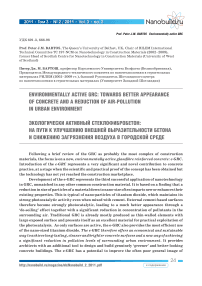Environmentally active GRC: towards better appearance of concrete and a reduction of air-pollution in urban environment
Автор: Bartos Peter J.M.
Журнал: Нанотехнологии в строительстве: научный интернет-журнал @nanobuild
Рубрика: Юбилеи и юбиляры
Статья в выпуске: 2 т.3, 2011 года.
Бесплатный доступ
Following a brief review of the GRC as probably the most complex of construction materials, the focus is on a new, environmentally active glassfibre reinforced concrete: e-GRC. Introduction of the e-GRC represents a very significant and novel contribution to concrete practice, at a stage when the scientific and practical proof of the concept has been obtained but the technology has not yet reached the construction marketplace. Development of the e-GRC represents the third successful application of nanotechnology in GRC, unmatched in any other common construction material. It is based on a finding that a reduction in size of particles of a material down to nano-size often imparts new or enhances their existing properties. This is typical of nano-particles of titanium dioxide, which maintains its strong photocatalytic activity even when mixed with cement. External cement-based surfaces therefore become strongly photocatalytic, leading to a much better appearance through a 'de-soiling' effect together with a significant reduction in concentration of pollutants in the surrounding air. Traditional GRC is already mostly produced as thin-walled elements with large exposed surface and presents itself as an excellent material for practical exploitation of the photocatalysis. As only surfaces are active, the e-GRC also provides the most efficient use of the nano-sized titanium dioxide. The e-GRC therefore offers an economical and sustainable way to achieve long-lasting, cleaner and brighter concrete surfaces and a new way of achieving a significant reduction in pollution levels of surrounding urban environment. It provides architects with an additional tool to design and build genuinely 'greener' and better-looking concrete buildings. The e-GRC has a potential to improve the often poor general image of concrete, which tends to be associated with dirty buildings in polluted urban 'concrete jungles'. Benefits offered by the e-GRC indicate a more sustainable concrete construction with a direct and positive environmental impact is possible.
Environmentally active glassfibre reinforced concrete, composite materials, concrete matrix, nanoparticles, titanium dioxide, photocatalysis, self-cleaning capability, de-polluting of the air
Короткий адрес: https://sciup.org/14265547
IDR: 14265547 | УДК: 691.3,


